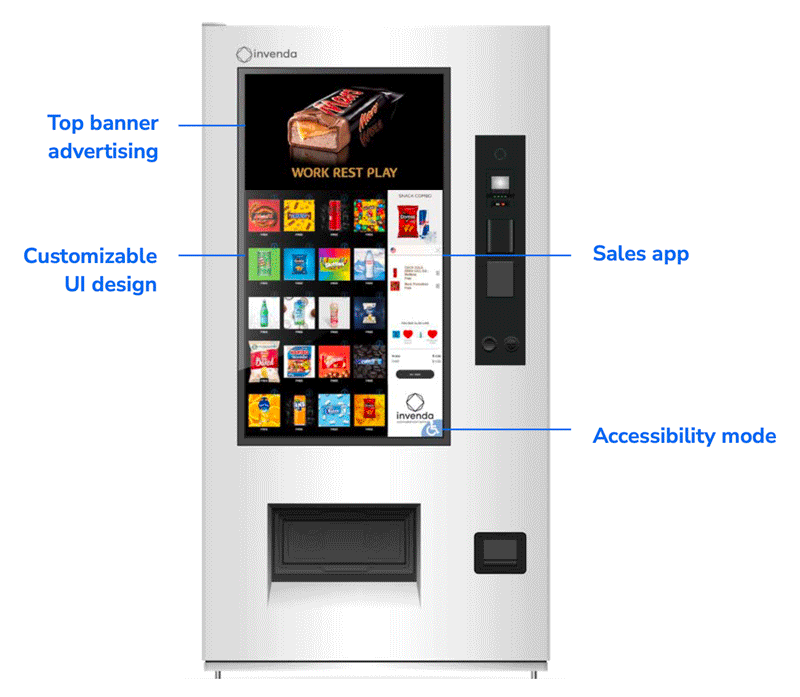Fill form to unlock content
Error - something went wrong!
Your content is just a step away. Please submit below.
Thank you!
Intelligent Vending Machines Power Retail Innovation

Most people have experienced the frustration of inserting cash into a vending machine, only to have it fail to deliver the snack they wanted. Today’s intelligent machines offer a very different experience. Looking more like a digital kiosk, an automated retail machine can interact with your mobile device, allow for touchless payment, make product recommendations, and blend a familiar online shopping experience with goods available immediately.
As retail embraces digital transformation, brands look for ways to maximize sales and build relationships with customers through omnichannel experiences. Automated retail machines provide new avenues for customer connections—and create a delivery system for digital out-of-home (DOOH) advertising, unlocking new revenue streams for retailers.
When adopted by regional operators and fast-moving consumer goods (FMCG) brands like Mars Wrigley, Invenda Group AG, a creator of automated retail solutions, provides vending machines that change the game. “Our machines merge a physical location with a digital presence,” says Mark Crandell, Chief Commercial Officer at Invenda. “We believe this is the next innovation in retail.”
For example, one Invenda global partner is an FMCG brand that has deployed several thousand smart machines around the world. The company carried out its own case studies to test performance—replacing traditional machines with intelligent ones, or placing them side by side to evaluate which performed better. In both cases, the Invenda Intelligent vending machines consistently generated between 20% and 70% more sales than their traditional counterparts.
Because they are connected to the internet, automated retail machines are also easier to service. “We can fix 90% of issues remotely, without a truck roll,” says Crandell. The machines can also report inventory from afar based on a predetermined planogram, and notify operators when certain products need restocking. That data allows them to load trucks intelligently and efficiently instead of showing up to find out what the machine needs. According to Invenda analyses, these efficiencies reduce overall technical Interventions by about 30%.
“Our machines merge a physical location with a #digital presence. We believe this is the next innovation in #retail” – Mark Crandell, @invendagroupag via @insightdottech
Automated Retail Machines Offer Real-Time Engagement Data
The Intel-powered Invenda automated retail machine functions as an ecosystem of both hardware and software components that serves as a point of sale (POS), an advertising platform, a remote management system, and a source of valuable consumer insights (Figure 1). Every machine has an oversized touchscreen display with a menu system and familiar user interface similar to that of an online store. Customers can interact with the machine through the touchscreen or by scanning a QR code and accessing the menu system on a mobile device.

“Whether they’re in front of the machine or not, we enable a digital shopping experience that’s familiar and easy to navigate,” says Crandell. When consumers interact with the platform, operators can gather anonymized data on sales trends, demographics, and cross-selling opportunities. Crandell explains, “For example, data might reveal that when someone puts a candy bar in their cart, if you offer them a coupon for a soft drink, the likelihood of those two items being purchased and consumed together goes up by a certain percentage.”
The data often reveals unexpected information about consumer behavior—information that may be difficult to obtain in other ways. For example, when a shopper visits a brick-and-mortar store after seeing an ad in the newspaper, their decision-making may be very different than when they are standing alone in front of a vending machine, making an impulse purchase. Crandell says, “Those two buyer behaviors are very different, and we want to create the data to inform brands that you might have more than one persona buying a certain product, depending on the situation.”
Operators and brands can access data through a centralized dashboard where they can view real-time reports on all the machines they have deployed. They can see a snapshot of sales on a particular day in aggregate or by specific machine or location—and they can run their own analytics to delve for deeper insights or have Invenda create a report for them for an added fee.
The system also includes a machine learning algorithm that tries to understand pricing in relation to the time of day, events in the surrounding area, and variables such as weather. For example, one of Invenda’s partners operates machines on university campuses throughout the United States. On football game days, it can schedule ahead to raise the price of soft drinks and snacks to be in line with other vendors around the stadium.
Digital Out-of-Home Advertising Unlocks New Revenue Streams
Using the machine’s screen for DOOH is another important component of the ecosystem. “DOOH is the fastest-growing part of the advertising business today,” says Crandell. “Whether consumers are purchasing items from the machine or not, we’re able to produce revenue for the location owner by selling that advertising real estate.”
For example, a smart machine placed in a high-traffic airport terminal with a traffic sensor reports how many people walk by each day. When that traffic information is combined with demographic data—determined in real time by the Invenda platform—brands can make strategic moves to reach their target audience.
Connectivity will play an ever-increasing role in the future of retail, says Crandell, adding, “As consumers, we’re comfortable making purchases with our mobile devices, and brands want to make direct connections with customers. If we’re able to facilitate a true omnichannel experience, we believe brands can understand relationships between their products and customers in new ways.”
For brands and operators that want to stay ahead of the competition and discover new revenue streams, it’s time to join the latest retail revolution and embrace digital solutions like automated retail.
Edited by Georganne Benesch, Associate Editorial Director for insight.tech.